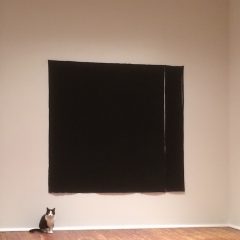
Maurice Sendak preliminary design for cover of Where the Wild Things Are (1963), courtesy Rosenbach Museum and Library, © Maurice Sendak
I love illustrated books; they’re one of the ancillary pleasures of being around small children. Art historians have lots of books with pictures but they’re not the same. By luck or intention, two exhibitions currently in Philadelphia present a wonderful range of illustrated books for children.
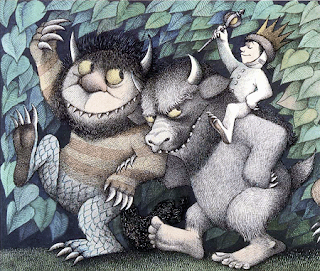
The Rosenbach Museum and Library has drawn on it’s archive of the artist’s work to present the major retrospective exhibition, Sendak on Sendak (through May 9, 2009). Over 130 works cover his career from the early illustrations for other writers’ texts (and here I must admit that a favorite book of my childhood was one of these: Ruth Krauss’s A Hole is to Dig) through the many books he wrote and illustrated, including Higglety, Pigglety, Pop! Or There Must be More to Life, The Night Kitchen, Outside Over There and many others. The exhibition includes sketches, dummy books and, most interestingly, several annotated page proofs as well as biographical material, memorabilia and several video interviews with the artist; the museum has planned numerous ancillary activities throughout the year, all listed on their website.
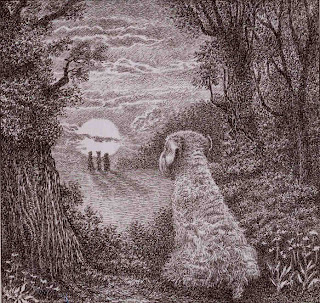
Maurice Sendak Original drawing for Higglety, Pigglety, Pop! (1967) pen and ink on paper, courtesy Rosenbach Museum and Library, © Maurice Sendak
Sendak’s work is so widely-known and beloved that it’s hard to remember the contretemps around the darker side of his stories as well as the anatomically-correct nude boy in The Night Kitchen (1970); in the wake of the cold war people seemed to forget the old tradition of scarey children’s stories (no coincidence that Sendak illustrated tales by the brothers Grimm). Of course Dr. Seuss was criticized around the same time for using irreverent language and making up words! Yet Sendak’s visual imagination and compelling style has made as much of an impression on the minds of several generations of young Americans as Dr. Seuss’ sensible nonsense. I’ve little doubt that if Sendak were forty years younger he’d have produced what are known as graphic novels, which after all are illustrated books for grown-ups. That genre is usually spoken of in connection with comic books, but the tie to traditions of illustrated children’s books strikes me as even stronger.

Maurice Sendak Preliminary drawing for Outside Over There (1977) pencil on vellum, courtesy Rosenbach Museum and Library, © Maurice Sendak
The exhibition is thematically-arranged around the topics of setting, influences and beasts. I was most curious about that devoted to influences, but it was clearer about Sendak’s familial and literary background (and his love for Mozart) than his visual influences. The artist acknowledges the influence of William Blake (whose work is on display), the German Romantic Philipp Otto Runge and the British painter known for his equine portraits, George Stubbs, as well as his love for the movies; the exhibition also shows that some of his illustrations derive from commercial portrait photography from the period when slow exposure time meant that the subjects had to hold stiff poses. Sendak’s style also betrays a knowledge of 16th-19th-century printmaking.
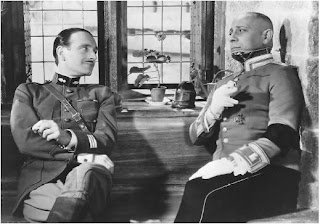
Pierre Fresnay (left) with Erich von Stroheim in Jean Renoir’s La Grande Illusion. The geranium on the window-sill shows up in one of Sendak’s works.
The most obvious visual citation is the final image in Higglety Pigglety, Pop!, where the protagonist, a dog named Jenny, stares out an open window with a potted geranium with a single bloom on the sill. This is too close to the scene of the geranium in the window in Jean Renoir’s La Grande Illusion (1937) to be mere coincidence, even if Sendak’s sheep-dog bears little resemblance to Erich von Stroheim.
The Rosenbach will rotate the visual material every four months so serious students of Sendak and book illustration in general will want to return.
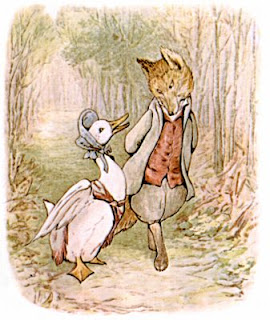
Beatrix Potter cover illustration to Tale of Jemima Puddle-Duck (1908) courtesy Guttenberg.org
Beyond This Time and Place: Children’s Books in England in the Rare Book Department of the Free Library (through Sept. 12, 2008; the area is being painted, so call before you go (215)686-5416; it should be open again by mid June) offers a range of material from the 18th through 20th century and serves as a perfect background for the Sendak exhibition as well as a delight in its own right. It begins with primers, ABC’s and reading books, including the delightful Butterfly’s Alphabet or Little Leonard’s Fly Trap (with multiple, hand-colored illustrations on each page) and the wonderfully-titled Cobwebs to Catch Flies; or Dialogs in Short Sentences, adopted to children from the Age of Three to Eight Years.
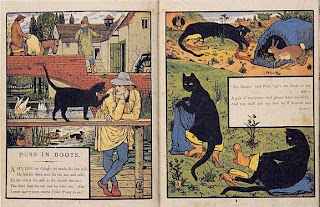
Walter Crane illustrated page spread from Puss in Boots. The library has another of his stunning illustrations on view.
The second case has two blocks for wood-engravings by Thomas Bewick and the exhibition is a compendium of illustrated books by the major figures in the field, including George Cruickshank, the brothers Dalziel, Walter Crane, Edmund Dulac, Arthur Rackham, Beatrix Potter, N.C. Wyeth, Randolph Caldecott and Kate Greenaway.
There are original sketches by several artists in ink and/or watercolor as well as sketches compared with their printed versions by Potter and Rackham. The labels include various interesting tid-bits about children’s books, such as the fact that one publisher in 1808 sold 40,000 copies of two titles in their first year of publication (pretty good considering that the audience must have been mostly in England). The text for the most visually-sophisticated illustration on view, Walter Crane’s New Toy Book of 1873 explains that part of its appeal results from improved methods of color printing. Crane’s is also the earliest instance where the visuals clearly supercede the text (both of which are unified into a double-page spread), a priority demonstrated throughout Maurice Sendak’s work as well.





